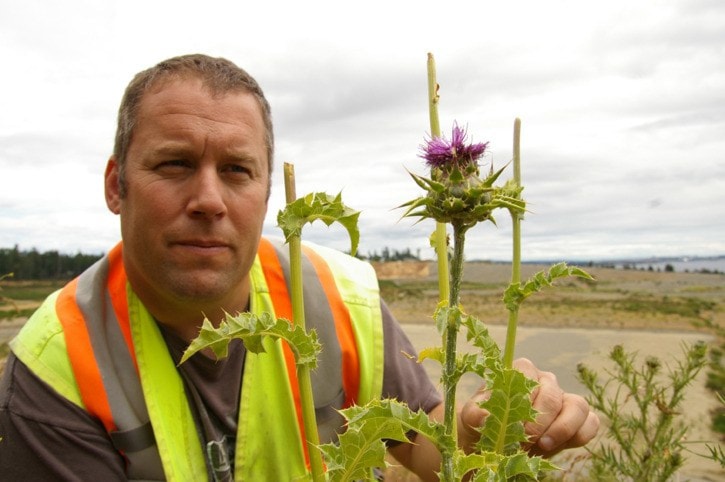It's been burned, coated in chemicals and attacked with clippers, and still the milk thistle continues to thrive in the Royal Bay nighbourhood of Colwood.
But City parks foreman Gord Beauvillier is hopeful the invasive weed will be fully eradicated from municipal property — eventually.
"This is one we can get under control. It hasn't spread to the point of being unmanageable," Beauvillier said.
The milk thistle likely found its way to the area in a contaminated bag of grass seed. A single plant can easily seed a whole hillside. Its pink-purple blossoms pack thousands of robust seeds that can lay dormant for at least nine years. Left unchecked it can easily choke our native species.
In 2009, when milk thistle was first spotted along the walkway between Promenade Crescent and Lehigh's former gravel pit, the fire department did a controlled burn of the area. In spring 2010 Beauvillier coated the area in Roundup, a broad-spectrum herbicide that killed the thistle and all the grass and shrubs around it.
But regrowth continued at about the same rate as previous years. This season parks staff clipped blooms off the thistle, but many plants sprouted new flowers. Beauvillier ordered Milestone, a strong herbicide that he'll put directly on each milk thistle to kill it without damaging surrounding species.
And next year he'll do it again.
"This won't be the end of it," Beauvillier said. "Next year we'll try getting the Milestone on it earlier in the season, before the blossoms come out."
Milk Thistle is one of about 10 invasive species that has reached Colwood, the most prolific of which is Scotch broom. But it's considered the highest priority for eradication because it was so recently introduced and can cause huge damage.
Despite some medicinal applications, the plant's broad greenish-white leaves are toxic to animals that eat them. Milk thistle has stalks are covered in sharp spikes and can grow up to six feet tall.
Most of the milk thistle known to be around Colwood is in municipal parks and in on the Lehigh land, where the owner is actively spraying it. Residents who see the plant on their property should carefully dig it out of the ground and seal it in a garbage bag marked "milk thistle" and bring it out to the landfill.
For tips on removing the plant, call Colwood parks staff at 250-474-4133.
news@goldstreamgazette.com
